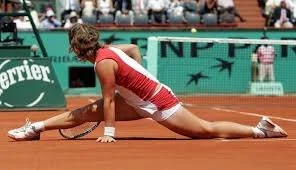Nick Bollettieri said at the 2019 U.S. Open, "You're as good as your fitness takes you." For your first-round match, you'll be fresh and ready to fight with all you've got. After that match, if your opponent was tough, your body might feel beat-up and depleted. The constant sprinting, stopping, and changing directions cause stress and tension for your muscles. Playing also takes up energy, and sweating expels electrolytes. The cost of playing thus reduces your ability to play at full capacity and constrains your game. Stretching, resting, and good nutrition will get you closer to your baseline fitness.
Stretching is your best friend. Your primary form of physical recovery will consist of stretching. Stretching will help you increase blood flow into your muscles and help flush out toxins accumulated during an intense tennis session. Stretching will also help you heal faster and bring back your full range of motion. The mental engagement from stretching is meditative and will help calm your mind. However, if you avoid stretching, each subsequent match will lead to tighter muscles and fatigue. Muscular tightness could lead to injuries.
When to stretch and how intense should you make it? I'm going to ignore some of the convention on this and use my personal experience. I've always been told to stretch right after my match but realized as a young adult that it helped only a little. After a long brutal match, you're beat. I learned that resting and replenishing myself with nutrients should be a priority and then, after some rest, allocating a good hour to warm up and stretch was most effective. So, the alternative approach is as follows:
Immediately after my match, I would jog for 5 minutes and do a very light stretch (about 10 minutes). Barely any pull or pressure on the muscles. All I did was find a comfortable position and use gravity to help with the stretch. Doing this helped me loosen up and recover some range of motion.
I would let my body recover for the day, hydrate, and supply myself with plenty of nutrients and electrolytes (more on that here). After resting, I would jog or cycle for 20 minutes to warm up my body again. Then I would get into a 30-minute full-body stretch. The prior recuperation always provided me the energy to focus on stretching properly. This is where I felt I optimized the most of my stretching and helped the body get back its full range of motion. Make sure to listen to your body. If you feel you have a deep tear somewhere, avoid stretching it. Your goal is to help with recovery and not push your limits.
Stretching should be your baseline post-match recovery routine. If you're a competitive athlete looking to make a bigger dent in the rankings, then you must also incorporate fitness training and some tennis practice as well so you can use the time spent at tournaments to improve.

